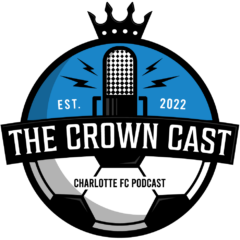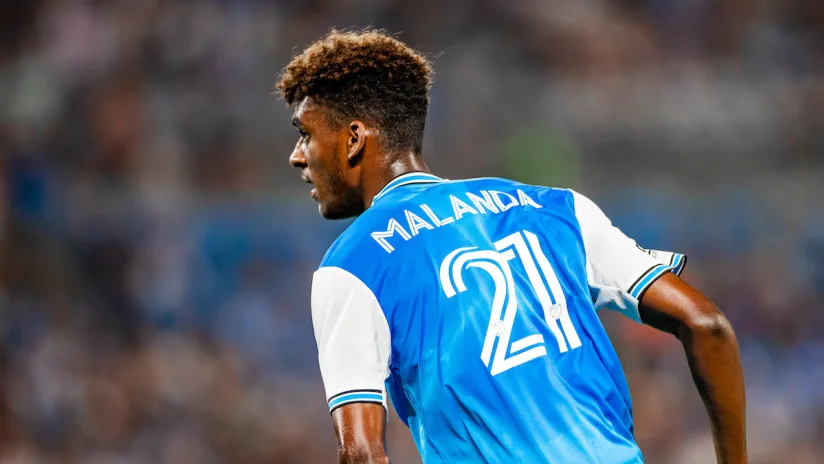When Charlotte made their summer signings, I was of the opinion that the least likely to provide a meaningful impact for us in 2022 was going to be Adilson Malanda. A 20-year-old CB coming from Ligue 2. Nah, he was going to ride the bench. I figured Nuno Santos would immediately play and Nathan Byrne would take over the RB spot. I was…wrong.
Unhappily, Guzman Corujo went down with injury in August. Initially, this thrust Jan Sobociński into the starting lineup, though his own injury woes would force him out. It then fell to the young Malanda to pair with Anton Walkes.
As a quick aside: Jan has been a forgotten man when it comes to this backline. Not even 24, he showed real flashes in his time on the pitch last year. Multiple injuries really derailed his season, but if he can shake the injury bug, I believe there is a real player in there.
I don’t think Walkes’ veteran presence should be overlooked when it comes to Malanda’s successful run of form. Malanda’s own ability carried him through his first games in MLS, but Walkes was a steadying presence for him.
Editor’s note: This post was written before Walkes’ death and already included this reference to Walkes and his veteran leadership. These were Josh’s thoughts before his passing and it feels even more appropriate to retain them in the post now.
It was and continues to be difficult not to be incredibly excited about Malanda’s potential. I’m very much a cautious individual when it comes to young players. While I prefer a talented young player over an aging vet (see: Jóźwiak vs. Reyna), I hesitate to believe in good performances too quickly. Young players tend to go through rough patches. The highs can be great but the lows can be as well.
Malanda will enter the 2023 MLS season as a 21-year-old CB with 6 games (in MLS) to his name. That is it. It is very likely–and even expected–that he will have a run of poor performances. Very few CBs his age start consistently at clubs and fewer still do so at a consistently high level. The ones that do are the elite of the elite. In my time watching soccer, only a few jump immediately to my mind: Thiago Silva, Marquinhos, and William Saliba (yes, Justin, Logan and I will mention him at every opportunity). These are obviously different players in much tougher leagues than MLS. They are also probably better players than Malanda will ever be (we’re talking about one of the best CBs ever in Silva, a CB who has been a starter for Roma and PSG since he was 18 in Marquinhos, and the young player of the year in France last year who has been a standout on the league-leading Arsenal). That is not a knock on Malanda, as he seems to have the potential to be a top CB in MLS, if not force his way back to Europe.
When looking at CBs, there are a few things I look for, aside from the ability to tackle.
- He needs to be at least 6’0″. Yes, I am a height snob when it comes to CBs. I want them to be bullies and command the penalty area.
- He needs to be able to progress the ball out from the back. This comes in the form of passing, but also dribbling ability. I don’t need a CB to be Neymar on the ball, but he should have the technical ability and on-ball confidence to turn a defender from time to time or take the space when it is given.
- He needs to be able to chip in 3-5 goals per year.
- He needs the pace to be able to recover. A CB is never going to win a footrace with the likes of Gaines, Ruan, or some of the other quicker players in the league. However, he needs to have enough pace to match up with 80% of the forwards in a league and the wherewithal to manage his limitations against the quicker players.
How does Malanda stack up with these “requirements”?
Quick note: I will be using FBref stats and their scouting report. We should take the scouting report percentages with a HUGE grain of salt. Malanda has 6 games in MLS. It’s an incredibly small sample size, however, I think it’s still worthwhile to see how he is stacking up so far. I expect these numbers to change over a full season–some probably drastically.
Height
First, he’s listed at 6’1″ on Charlotte’s site (though he’s listed half an inch shorter on FBref). Having seen him in person, this seems about right. He’s only 165 lbs and looks it. He’s spindly and wiry, but that doesn’t seem to stop him from being physical in games. I would probably like to see him add about 10 pounds of muscle, but there’s a balance between him doing that and potentially losing some of his pace/quickness.
On-ball Ability
Malanda can pass. When he was first signed, there wasn’t much information out there for him. I found this video and what jumped out to me was his confidence to make a pass and run with the ball.
As with any YouTube highlight video, there aren’t bad plays in here–but his ability to be calm on the ball, go around a player, and make a pass are all evident.
Malanda’s passing ability is already evident, but I don’t think we’ve seen its full impact. This is probably due to Lattanzio. I don’t mean this in a disparaging way either. I imagine CL wanted to have Malanda focus on defending and leave the penetrative distribution to others. For a young player coming to a new league in a new country with a new language, this all makes sense.
On the season, Malanda attempted 376 total passes, good for 62.7 attempts per 90. That was good for 4th on the team behind Santos (71.7 passes attempted/90), Afful (71.5 passes attempted/90), and Fuchs (70.3 passes attempted/90). Technically, Hegardt led the team with 120 passes attempted/90 (!!!) but he had 0.2 90s, so it’s hard to really count him. Even Santos is a bit iffy to count with this, as he only had 1.8 90s. Regardless, the point is that even if Malanda wasn’t meant to be a focal point of distribution, he saw a lot of the ball.
Note: some of Charlotte’s struggles offensively can probably be traced to the fact that our defenders lead the team in passes attempted per 90. Hegardt and Santos, as previously mentioned, are dubious to include in these rankings due to their overall lack of playing time. Even if you do include them, though, 9 of our top 11 players in this category were defenders. If you exclude them, Bronico is the only non-defender to break the top 10 (51.3 passes attempted/90). That is problematic and something that has to be changed in the coming season. It’s also one of the reasons I view Santos as such an important player moving forward. It’s a very small sample size, but those 71.7 passes attempted/90 are much needed. Westwood, if healthy, should also help.
Of his 376 passes, Malanda completed 326 of them (54.3 completed passes/90) at an 86.7% clip. Breaking it down even further, most of his passing came in the medium range (194 completed of 207 attempted, 93.7% completion percentage). He completed 93 of 97 short passes (95.9%). Where I’m most excited to see him evolve is in his long passing; he only attempted 63 long passes last year, completing 37 of them (58.7%). In the video above, there were numerous times when he would hit a long diagonal ball to the wing. That’s something I would like to see from him more this year.
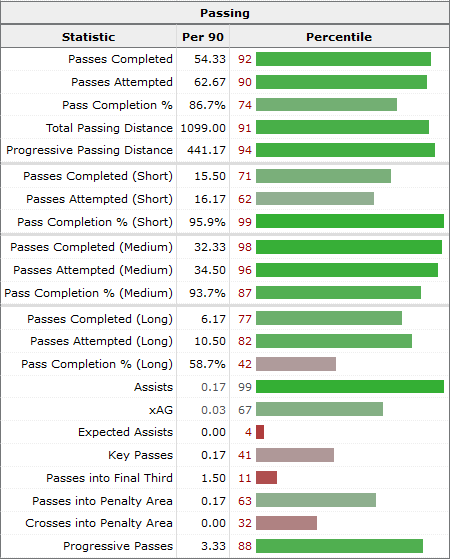
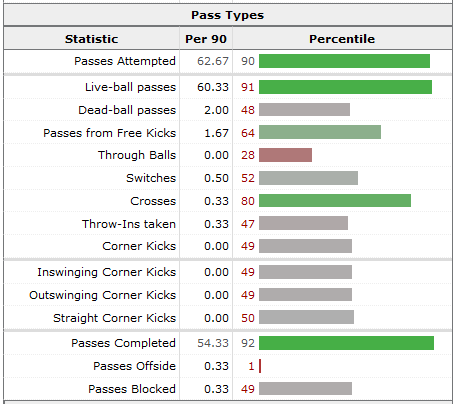
For a then-20-year-old, this is outstanding. Compared with his central defender peers, Malanda is already a league leader in passing. His one area of improvement needs to be with key passes, but, again, he was 20! We can nitpick a few areas if we want, but when there is this much green, you just enjoy it (while also continuing to acknowledge the all-important small sample size).
Goal Contribution
Goals are never the most important stat for a CB, but the very best teams always seem to have a CB who chips in some goals. Malanda has never actually scored a goal in his professional career and has only 1 assist (last year for Charlotte). Thus, there’s nothing in his history that necessarily leads you to believe that he could contribute 3-5 goals per season. Yet, I think he will and it’s mostly due to one thing: his ability to time runs and jumps.
Logan was one of the first people I heard mention this, but Malanda has already shown an ability to get himself into good positions from corners. He crashes down into the box.

Malanda doesn’t score this, but his run and jump from deep are so well-timed. It causes confusion in the box, which allows Świderski to finish off the chance.

This second one deserved a goal. It’s a fantastic ball in from Vargas and, again, Malanda’s run and jump are impeccable.
Of course, I would be remiss not to mention that the numbers don’t necessarily bear out his aerial ability. In fact, they show the opposite.
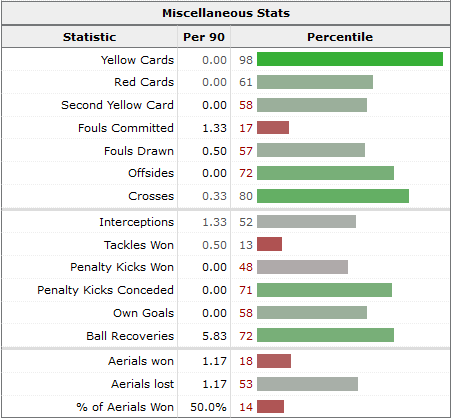
Yikes. Those numbers are not great and show a definite area of improvement. I predict–and am confident that–further game experience will improve these numbers.
Pace
Malanda has shown the ability to recover and provide cover for teammates. In the Chicago game, the second goal comes from a good move by Chicago and poor decision-making by Malanda’s veteran teammates, Walkes and Afful.

When the ball is played, Malanda is on the halfway line and a few good yards behind the fullback making a run. He covers the ground exceptionally well, forcing #2 on Chicago to cut back. Unfortunately, no one but Malanda and Byrne has tracked back well on this play and Chicago gets a goal.
This next angle shows it even better.

In general, you don’t want a CB to have to go full-bore, as that usually means a mistake has been made somewhere else. It will happen, though, and it’s good to know that Malanda has the ability to catch up.
With only 6 games under his belt at the MLS level–and only 40 total for his career–it’s far too soon to say exactly what Adilson Malanda is. This discussion has also largely ignored his tackling ability, so let’s take a look.

There is clearly room for improvement. His relative lack of errors is encouraging, as is his ability against dribblers. Of course, that ability hasn’t been extensively tested. FBref has him in only 3 duels vs. dribblers. While his 100% success rate in these situations is good (you certainly want him at 100% and not 0%), there’s not a big enough sample to say that it will be predictive of his future ability.
It should be noted that defensive stats are notoriously fickle and, of all the advanced stats, the least fleshed out, in my opinion. That is not to excuse these numbers; Malanda will need to improve them if he is to reach the heights the beginning of his Charlotte career has hinted at. To be a true defensive stopper, you will want him to get stuck in a bit more and have success while doing it. With that said, I don’t think these numbers need to be overly concerning for us just yet due to the small sample and age.
It’s hard not to dream about Malanda’s future. It does look that bright. Charlotte’s first overall pick, Diop, also shows some of these same traits (ball carrying, passing, physical build). Even Jan fits in this mold. It seems Charlotte has a CB prototype in mind.
For the upcoming year, all Charlotte fans should be excited for a Malanda-Corujo pairing, provided Corujo comes back healthy. This is not a given; ACLs, while common, are not easy injuries to come back from. They take time and there are often setbacks (usually in the form of muscular strains). Don’t be surprised if it takes a few months to see the pre-injury Corujo. It could even take most of next year.
Once Corujo does get back, this pairing should really complement each other. I’ve long said that Corujo’s biggest weakness was his lack of distribution. This deficit should be covered by Malanda’s on-ball ability.
Malanda, meanwhile, is still learning how to tackle and defend at a high level. Corujo is an aggressive defender, which I know worries some. While his aggressiveness can cause issues, he is a really good tackler and defensive stopper (91st percentile in tackles and tackles won, 96th percentile in tackles in the defensive 3rd, 88th percentile in dribbles contested, 91st percentile in tackles plus clearances). His aggressiveness can get him caught out at times, but, again, I think Malanda’s pace and more balanced defending can help cover for that.
Center-back pairings often come down more to chemistry than talent. Yes, ability is important, but unless you have a generational talent (in which case, he’s not at Charlotte), you need to balance those abilities. I’m very optimistic about Malanda and Corujo doing just that. Even more than that, though, I’m confident in Malanda’s ability, regardless of the partner.
